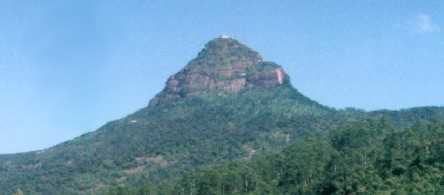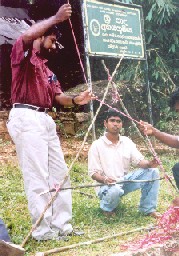SUSTAINABILITY IN PEAK WILDERNESS BUFFER ZONE
 |
The upper watershed management of Kelani valley and conservation of biological diversity in the Peak Wilderness Sanctuary-Maliboda, Dikellakanda area of Kegalle district of Sri Lanka. | |||||||||||||||||||||||||||||||||||||||||||||||||||||||||||||||||||||
|
Adam's peak and the Peak wilderness |
||||||||||||||||||||||||||||||||||||||||||||||||||||||||||||||||||||||
|
Adam’s Peak has been a well-known sacred place for Buddhists and Hindus for a long time. The territory is called the Peak Wilderness because of its high environmental value and rich biological diversity. Today, this area is recognized as one of the most important environmentally important zones in Sri Lanka of both cultural and historical value to the country. Further, this region serves as the main watershed for several major rivers. Hence, environmental changes affecting the Peak Wilderness are likely to influence development of adverse climatic changes in the major part of the Island. Peak wilderness Sanctuary is bounded by the Nuwara Eliya, Ratnapura and Kegalle districts. It is located in the wet highland zone of Sri Lanka at an altitude of 1000-2500 msl and comprises both intermediate wetlands and wet highlands. Several very rare as well as endemic and globally threatened flora and fauna species are found here. Recent explorations carried out in this area have indicated the vulnerability of the ecology of this unique environment. Both pilgrims and cultivators have significantly polluted the sanctuary area, which belongs to the Ratnapura and Nuwara Eliya districts. It is fortunate that the area of the sanctuary located in the Kegalle district is still relatively unharmed. A considerable extent of land in the western slope of the sanctuary belongs to Kegalle district and comprises the upper watershed of the Seethawaka river, one of the main tributaries of the Kelani River. Many streams in this area provide an important habitat for several species of endemic and globally threatened fishes, and the entire area is highly rich in biological diversity. Several villages in the Deraniyagala Divisional Secretariat Division are in the buffer zone of the Peak wilderness sanctuary. These are Dikella-kanda, Wattegoda and Bambaragala. Covering about 10,200 acres, the Dikella-kanda Grama Niladhari Division is the largest in the Kegalle district. Much of the land is within limits of the sanctuary, leaving around 600 acres for cultivation and home gardens. Sri Lanka Environment Exploration Society (SLEES), a non-governmental organization dedicated to conservation of the environment based in Kegalle, recognizing the immeasurable value of the biological diversity rich forested area explored it in the latter part of 1999. By this time, the SLEES team, comprising university graduates, students and field experts, had successfully explored 12 forest reserves in the Kegalle district, including the unique ‘bird-forest’- Kurulu Kele- of Kegalle. With accumulated previous experience in exploring and identifying of flora and fauna species, SLEES team collected data on almost all flora and fauna species in the Dikella- kanda area. The information collected by the SLEES team provided sufficient evidence to conclude that there are many threats to this sanctuary due to certain human activities. This gave rise to the need to form a conservation plan to prevent further environmental degradation and loss of biological diversity in a sustainable manner. To achieve this, SLEES turned to the United Nations Development Program that helps to conserve the nature under the theme of Biological Diversity and Climate Change. The Global Environment Facility / Small Grant Programme (GEF/ SGP) active in Sri Lanka too, agreed to support this project entitled ‘Conservation of Biological Diversity in the Peak wilderness sanctuary and Management of the Upper watershed of Kelani Valley’, under instructions of its National Coordinator. At present there are about 190 families in the project implementation area. Most of the people cultivate tea for their livelihood while a few work in the government and private sectors. Poor soil conservation in tea cultivation leading to soil erosion is widespread in the project area. It has also been noted that pollution of streams with agro-chemicals and fertilizers occurs at an alarming rate. The main threats to the sanctuary include deforestation for firewood extraction, illegal clearing for tea cultivation, collecting medicinal plants and distilling of illicit liquor along the stream banks. All families use firewood for cooking and 72% of them collect firewood directly from the forest. Considering the above, SLEES planned the project with the following objectives. Objectives: 1. To conserve and properly manage the upper watershed of the Kelani valley. 2. To minimize soil erosion of the upper watershed of the Kelani valley. 3. To minimize pollution of streams with chemical substances. 4. To conserve the biological diversity of the block of the sanctuary which belongs to Kegalle district. 5. To conserve endemic and threatened species of flora and fauna in the region. Importance of project implementation: The project attempts to conserve the natural habitat and environment systems within and outside the protected and reserved forest. Activities are designed to persuade communities residing close by to make sustainable use of forest resources and hence to conserve forests. Efforts will be directed at conserving the threatened forest systems by introducing an integrated management system with high sustainability for agricultural lands as well as forestlands. Micro-hydropower systems will be installed to harness the power of small streams to provide electricity to villages, not likely to receive power from the national grid. Under this sustainable development project, several activities have already been completed while many are yet to be implemented. Project activities:
By implementing the above activities and related sub-activities, the following results are expected;
All these activities are aimed at achieving high sustainability of the forest system as well as its denizens, while ensuring a decent living for the villagers. Sustainability will be ensured by adopting a participatory approach with the active involvement of public sector and community development officers and community-based organizations.
|
||||||||||||||||||||||||||||||||||||||||||||||||||||||||||||||||||||||
A site by - Heritage Creations hericre@hotmail.com

